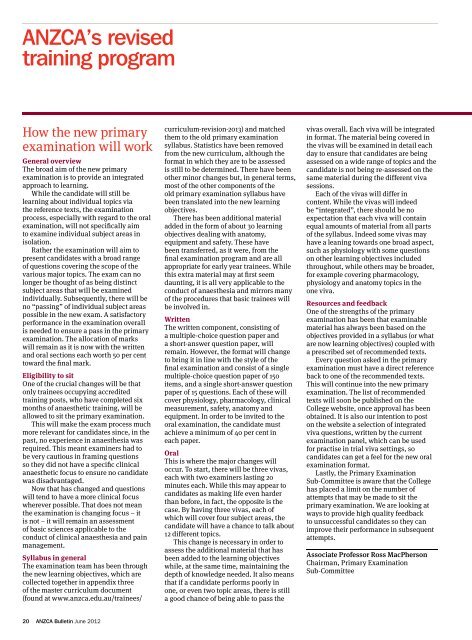ANZCA Bulletin June 2012 - final.pdf - Australian and New Zealand ...
ANZCA Bulletin June 2012 - final.pdf - Australian and New Zealand ...
ANZCA Bulletin June 2012 - final.pdf - Australian and New Zealand ...
- No tags were found...
You also want an ePaper? Increase the reach of your titles
YUMPU automatically turns print PDFs into web optimized ePapers that Google loves.
<strong>ANZCA</strong>’s revisedtraining programHow the new primaryexamination will workGeneral overviewThe broad aim of the new primaryexamination is to provide an integratedapproach to learning.While the c<strong>and</strong>idate will still belearning about individual topics viathe reference texts, the examinationprocess, especially with regard to the oralexamination, will not specifically aimto examine individual subject areas inisolation.Rather the examination will aim topresent c<strong>and</strong>idates with a broad rangeof questions covering the scope of thevarious major topics. The exam can nolonger be thought of as being distinctsubject areas that will be examinedindividually. Subsequently, there will beno “passing” of individual subject areaspossible in the new exam. A satisfactoryperformance in the examination overallis needed to ensure a pass in the primaryexamination. The allocation of markswill remain as it is now with the written<strong>and</strong> oral sections each worth 50 per centtoward the <strong>final</strong> mark.Eligibility to sitOne of the crucial changes will be thatonly trainees occupying accreditedtraining posts, who have completed sixmonths of anaesthetic training, will beallowed to sit the primary examination.This will make the exam process muchmore relevant for c<strong>and</strong>idates since, in thepast, no experience in anaesthesia wasrequired. This meant examiners had tobe very cautious in framing questionsso they did not have a specific clinicalanaesthetic focus to ensure no c<strong>and</strong>idatewas disadvantaged.Now that has changed <strong>and</strong> questionswill tend to have a more clinical focuswherever possible. That does not meanthe examination is changing focus – itis not – it will remain an assessmentof basic sciences applicable to theconduct of clinical anaesthesia <strong>and</strong> painmanagement.Syllabus in generalThe examination team has been throughthe new learning objectives, which arecollected together in appendix threeof the master curriculum document(found at www.anzca.edu.au/trainees/curriculum-revision-2013) <strong>and</strong> matchedthem to the old primary examinationsyllabus. Statistics have been removedfrom the new curriculum, although theformat in which they are to be assessedis still to be determined. There have beenother minor changes but, in general terms,most of the other components of theold primary examination syllabus havebeen translated into the new learningobjectives.There has been additional materialadded in the form of about 30 learningobjectives dealing with anatomy,equipment <strong>and</strong> safety. These havebeen transferred, as it were, from the<strong>final</strong> examination program <strong>and</strong> are allappropriate for early year trainees. Whilethis extra material may at first seemdaunting, it is all very applicable to theconduct of anaesthesia <strong>and</strong> mirrors manyof the procedures that basic trainees willbe involved in.WrittenThe written component, consisting ofa multiple-choice question paper <strong>and</strong>a short-answer question paper, willremain. However, the format will changeto bring it in line with the style of the<strong>final</strong> examination <strong>and</strong> consist of a singlemultiple-choice question paper of 150items, <strong>and</strong> a single short-answer questionpaper of 15 questions. Each of these willcover physiology, pharmacology, clinicalmeasurement, safety, anatomy <strong>and</strong>equipment. In order to be invited to theoral examination, the c<strong>and</strong>idate mustachieve a minimum of 40 per cent ineach paper.OralThis is where the major changes willoccur. To start, there will be three vivas,each with two examiners lasting 20minutes each. While this may appear toc<strong>and</strong>idates as making life even harderthan before, in fact, the opposite is thecase. By having three vivas, each ofwhich will cover four subject areas, thec<strong>and</strong>idate will have a chance to talk about12 different topics.This change is necessary in order toassess the additional material that hasbeen added to the learning objectiveswhile, at the same time, maintaining thedepth of knowledge needed. It also meansthat if a c<strong>and</strong>idate performs poorly inone, or even two topic areas, there is stilla good chance of being able to pass thevivas overall. Each viva will be integratedin format. The material being covered inthe vivas will be examined in detail eachday to ensure that c<strong>and</strong>idates are beingassessed on a wide range of topics <strong>and</strong> thec<strong>and</strong>idate is not being re-assessed on thesame material during the different vivasessions.Each of the vivas will differ incontent. While the vivas will indeedbe “integrated”, there should be noexpectation that each viva will containequal amounts of material from all partsof the syllabus. Indeed some vivas mayhave a leaning towards one broad aspect,such as physiology with some questionson other learning objectives includedthroughout, while others may be broader,for example covering pharmacology,physiology <strong>and</strong> anatomy topics in theone viva.Resources <strong>and</strong> feedbackOne of the strengths of the primaryexamination has been that examinablematerial has always been based on theobjectives provided in a syllabus (or whatare now learning objectives) coupled witha prescribed set of recommended texts.Every question asked in the primaryexamination must have a direct referenceback to one of the recommended texts.This will continue into the new primaryexamination. The list of recommendedtexts will soon be published on theCollege website, once approval has beenobtained. It is also our intention to poston the website a selection of integratedviva questions, written by the currentexamination panel, which can be usedfor practise in trial viva settings, soc<strong>and</strong>idates can get a feel for the new oralexamination format.Lastly, the Primary ExaminationSub-Committee is aware that the Collegehas placed a limit on the number ofattempts that may be made to sit theprimary examination. We are looking atways to provide high quality feedbackto unsuccessful c<strong>and</strong>idates so they canimprove their performance in subsequentattempts.Associate Professor Ross MacPhersonChairman, Primary ExaminationSub-Committee20 <strong>ANZCA</strong> <strong>Bulletin</strong> <strong>June</strong> <strong>2012</strong>
















